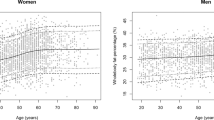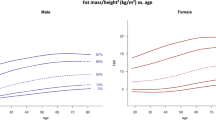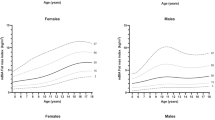Abstract
Background/Objectives:
The prevalence of obesity, defined as body mass index (BMI) ⩾30 kg/m2, differs between populations; however, there is a need for data on description on body composition in reference populations of different ages and from different countries. The objective of this study was to pool dual-energy X-ray absorptiometry (DXA) body composition reference data from population-based Swedish cohorts.
Subjects/Methods:
Four population-based cross-sectional cohort studies including 1424 adult Swedes were divided into five age groups (20–29, 30–39, 40–49, 50–61 and 75 years of age); BMI 24.6±3.9 kg/m2 were pooled. Body composition was measured with DXA.
Results:
The difference in BMI from the youngest to the oldest age group was 3.2 and 4.3 kg/m2 in men and women, respectively (P<0.001, both sexes), and fat mass (FM) was 9.9 and 9.1% higher in the oldest compared with the youngest men and women (P<0.001, both sexes). Fat-free mass (FFM) remained stable up to 60 years of age in men (P=0.83) and was lower at 75 years of age compared with the younger ages. In women, FFM was lower from age 60. From youngest to oldest age groups, height-adjusted FM differed from 4.6 to 7.8 kg/m2 in men and from 6.8 to 10.8 kg/m2 in women (P<0.001, both sexes).
Conclusions:
Our results provide reference data on body composition in Swedish populations. BMI and FM were higher among older age groups compared with the younger ones. FFM remained stable up to 60 years of age and was lower first among the 75 years of age.
This is a preview of subscription content, access via your institution
Access options
Subscribe to this journal
Receive 12 print issues and online access
$259.00 per year
only $21.58 per issue
Buy this article
- Purchase on Springer Link
- Instant access to full article PDF
Prices may be subject to local taxes which are calculated during checkout

Similar content being viewed by others
References
Ahima RS . Digging deeper into obesity. J Clin Invest 2011; 121: 2076–2079.
Li C, Ford ES, Zhao G, Balluz LS, Giles WH . Estimates of body composition with dual-energy X-ray absorptiometry in adults. Am J Clin Nutr 2009; 90: 1457–1465.
Schutz Y, Kyle UU, Pichard C . Fat-free mass index and fat mass index percentiles in Caucasians aged 18-98 y. Int J Obes Relat Metab Disord 2002; 26: 953–960.
Kyle UG, Melzer K, Kayser B, Picard-Kossovsky M, Gremion G, Pichard C . Eight-year longitudinal changes in body composition in healthy Swiss adults. J Am Coll Nutr 2006; 25: 493–501.
Larsson I, Berteus Forslund H, Lindroos AK, Lissner L, Naslund I, Peltonen M et al. Body composition in the SOS (Swedish Obese Subjects) reference study. Int J Obes Relat Metab Disord 2004; 28: 1317–1324.
Gummesson A, Jernas M, Svensson PA, Larsson I, Glad CA, Schele E et al. Relations of adipose tissue CIDEA gene expression to basal metabolic rate, energy restriction, and obesity: population-based and dietary intervention studies. J Clin Endocrinol Metab 2007; 92: 4759–4765.
Tengvall M, Ellegard L, Malmros V, Bosaeus N, Lissner L, Bosaeus I . Body composition in the elderly: reference values and bioelectrical impedance spectroscopy to predict total body skeletal muscle mass. Clin Nutr 2009; 28: 52–58.
Lantz H, Bratteby L-E, Fors H, Sandhagen B, Sjöström L, Samuelson G . Body composition in a cohort of Swedish adolescents aged 15, 17 and 20.5 years. Acta Pædiatrica 2008; 97: 1691–1697.
Sjöström L, Larsson B, Backman L, Bengtsson C, Bouchard C, Dahlgren S et al. Swedish obese subjects (SOS). Recruitment for an intervention study and a selected description of the obese state. Int J Obes Relat Metab Disord 1992; 16: 465–479.
Kim J, Heshka S, Gallagher D, Kotler DP, Mayer L, Albu J et al. Intermuscular adipose tissue-free skeletal muscle mass: estimation by dual-energy X-ray absorptiometry in adults. J Appl Physiol 2004; 97: 655–660.
Deurenberg-Yap M, Chew SK, Deurenberg P . Elevated body fat percentage and cardiovascular risks at low body mass index levels among Singaporean Chinese, Malays and Indians. Obes Rev 2002; 3: 209–215.
Deurenberg-Yap M, Deurenberg P . Is a re-evaluation of WHO body composition cut-off values needed? The case of Asians in Singapore. Nutr Rev 2003; 61: S80–S87.
Baumgartner RN, Heymsfield SB, Roche AF . Human body composition and the epidemiology of chronic disease. Obes Res 1993; 3: 73–95.
Buffa R, Floris GU, Putzu PF, Marini E . Body composition variations in ageing. Collegium Antropologicum 2011; 35: 259–265.
Kyle UG, Schutz Y, Dupertius YM, Pichard C . Body composition Interpretation: contribution of fet-free mass index and the body fat mass index. Nutrition 2003; 19: 597–604.
Larsson I, Henning B, Lindroos AK, Näslund I, Sjöström CD, Sjöström L . Optimized predictions of absolute and relative amounts of body fat from weight, height, other anthropometric predictors and age. Am J Clin Nutr 2006; 83: 252–259.
Hull HR, Thornton J, Wang J, Pierson RN Jr, Kaleem Z, Pi-Sunyer X et al. Fat-free mass index: changes and race/ethnic differences in adulthood. Int J Obes (Lond) 2011; 35: 121–127.
Samuelsson C, Hagman A . We are Putting on Weight on the Waistline. (Vi växer på bredden). Statistics Sweden: Stockholm, 2012.
Acknowledgements
We acknowledge Björn Henning, Institute of Medicine, Sahlgrenska Academy, University of Gothenburg for his skilful work with the DXA body composition databases.
Author information
Authors and Affiliations
Corresponding author
Ethics declarations
Competing interests
The authors declare no conflict of interest.
Rights and permissions
About this article
Cite this article
Larsson, I., Lissner, L., Samuelson, G. et al. Body composition through adult life: Swedish reference data on body composition. Eur J Clin Nutr 69, 837–842 (2015). https://doi.org/10.1038/ejcn.2014.268
Received:
Revised:
Accepted:
Published:
Issue Date:
DOI: https://doi.org/10.1038/ejcn.2014.268
This article is cited by
-
Comparison of the 2010 and 2019 diagnostic criteria for sarcopenia by the European Working Group on Sarcopenia in Older People (EWGSOP) in two cohorts of Swedish older adults
BMC Geriatrics (2021)
-
Benchmarking the Discriminatory Performance of Body Mass Index and Body Fat for Obesity Detection in Patients Treated by Intragastric Balloon
Obesity Surgery (2021)
-
Reference values for body composition and associations with blood pressure in Kenyan adults aged ≥50 years old
European Journal of Clinical Nutrition (2019)
-
Preserved Fat-Free Mass after Gastric Bypass and Duodenal Switch
Obesity Surgery (2017)



